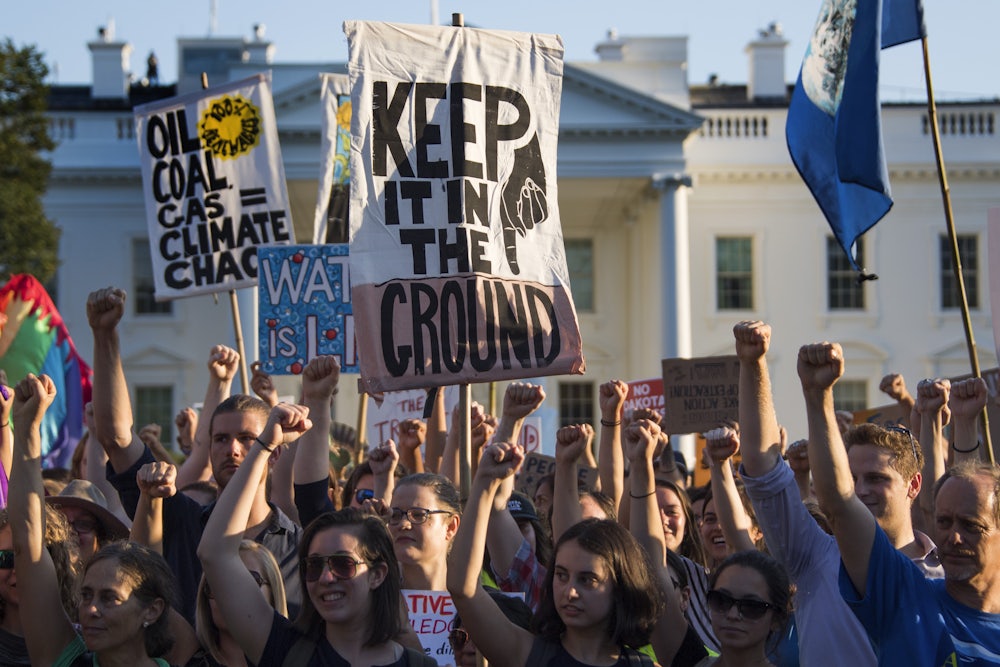Well-heeled climate and energy wonks have long sought elegant market solutions to lower greenhouse gas emissions—tax incentives for green energy, or carbon pricing to gently nudge companies toward a low-carbon future. But in the past 24 hours, multiple breaking news events have pointed to what may be a more efficient, less genteel tool for stopping fossil fuel projects in their tracks: social movements. Sunday evening, the energy companies behind the planned Atlantic Coast Pipeline announced their plans to abandon the pipeline project, just a few weeks after New York State rejected the Williams Pipeline. Monday morning, a federal judge ordered a temporary shutdown of the Dakota Access Pipeline (DAPL), citing its slapdash environmental review process. All of the above represented big blows to the fossil fuel industry and huge wins for the Indigenous communities and organizers that have worked to block these projects from their inception.
Just take Energy Secretary Dan Brouillette’s word for it. “The well-funded, obstructionist environmental lobby has successfully killed the Atlantic Coast Pipeline,” Brouillette wrote in a press statement Sunday, adding that the project is “no longer economically viable due to the costly legal battles they would continue to face.” Over the past few years, a full-court press of legal challenges and mounting pressure from Indigenous tribes and a wide range of organizers had delayed the project and nearly doubled its projected cost—from $4.5 billion to $8 billion.
Brouillette didn’t mention another factor in the ACP’s demise: Natural gas simply isn’t very good business anymore. Years of public pressure are a big part of that, adding to the myriad structural challenges facing the natural gas industry: chronic oversupply, natural gas producers’ mountains of debt, and Wall Street investors losing patience after years of unprofitability. Shale drillers in Appalachia have been hit particularly hard. Global coronavirus shutdowns added to the industry’s troubles by lowering demand across the board. For Duke and Dominion, the utilities behind the ACP, all this combined to make the pipeline a conspicuously bad deal. As the editorial board of the Raleigh News and Observer wrote in response to the ACP announcement, “What the ‘obstructionist environmental lobby’ actually did was hold off the pipeline long enough that Dominion and Duke could see it was becoming a boondoggle that would have cost them and their ratepayers dearly. The worldwide economic slowdown caused by the pandemic has created a fossil fuel glut that has rolled back the fracking industry. There is increasing evidence that there would not be enough energy demand or natural gas price stability to justify the volume or the cost of the pipeline.”
The ACP decision was announced alongside others pointing to utilities’ mixed feelings about the future of natural gas. Dominion also announced Sunday that it had sold the bulk of its natural gas assets—excluding its now-worthless interest in the ACP—to Warren Buffet’s Berkshire Hathaway, effectively doubling his company’s gas infrastructure footprint. Dominion, which announced its goal of achieving net-zero emissions by 2050 in February, has painted the move as a way to become more “sustainability focused”—part of its glacially slow walk toward carbon neutrality. A spokesperson for Berkshire Hathaway Energy “respectfully” declined to comment on its plans for Dominion’s gas properties, its first major purchase of the coronavirus era. Duke Energy told the trade site Utility Dive that natural gas “remains central to our long-term strategy, and we will continue to count on our employees to deliver industry-leading service to our customers.”
Following the ACP announcement, Brouillette staged a low-energy Twitter livestream with an energy executive Monday to announce his greenlighting of a controversial Berkshire Hathaway–backed natural gas export facility at Jordan Cove in Coos Bay, Oregon—a project widely opposed by tribal nations. He emphasized that the White House would continue doubling down on fossil fuels. “Today is a great day for American energy dominance,” the secretary urged defiantly. “This administration remains committed to promoting energy infrastructure projects throughout the country.”
Fossil fuel infrastructure threatens both communities in its spill-prone and polluting path as well as the global climate through the natural gas it helps burn in the near-term. But it also presents a long-term threat: Large infrastructure investments lock in continued fossil fuel usage for decades to come. The impact of successful fights against fossil fuel infrastructure—often led by the Indigenous communities in its path—reverberates beyond the projects they’re fighting, shifting the way other pipeline and fossil infrastructure projects are seen as well, and raising the political if not direct financial cost of natural gas investments. Ironically, Duke, Dominion, and the Trump administration all chalking their defeat up to activists’ efforts will only put more wind in activists’ sails.
Recent pipeline defeats in the courts, it’s worth noting, are also a testament to good old-fashioned environmental regulations and a reminder why the Clean Air Act and National Environmental Protection Act—the basis for the DAPL shutdown order—are still such boogeymen for the right. In the DAPL decision, U.S. District Judge James Boasberg wrote that, while shutting the project down might seem extreme, the extent of the DAPL environmental review’s flaws, “and the potential harm each day the pipeline operates,” was such that “the Court is forced to conclude that the flow of oil must cease.” Only time will tell whether DAPL backers think this debacle worth the continued investment, or whether they—like Dominion and Duke Energy—decide it’s time to cut their losses on a project whose payoff, even without the protests, seems increasingly uncertain.
Subtle market tweaks can do some good to decarbonize the energy system, but for keeping fossil fuels in the ground and preventing new infrastructure, the simpler solution may just be to give ’em hell.
